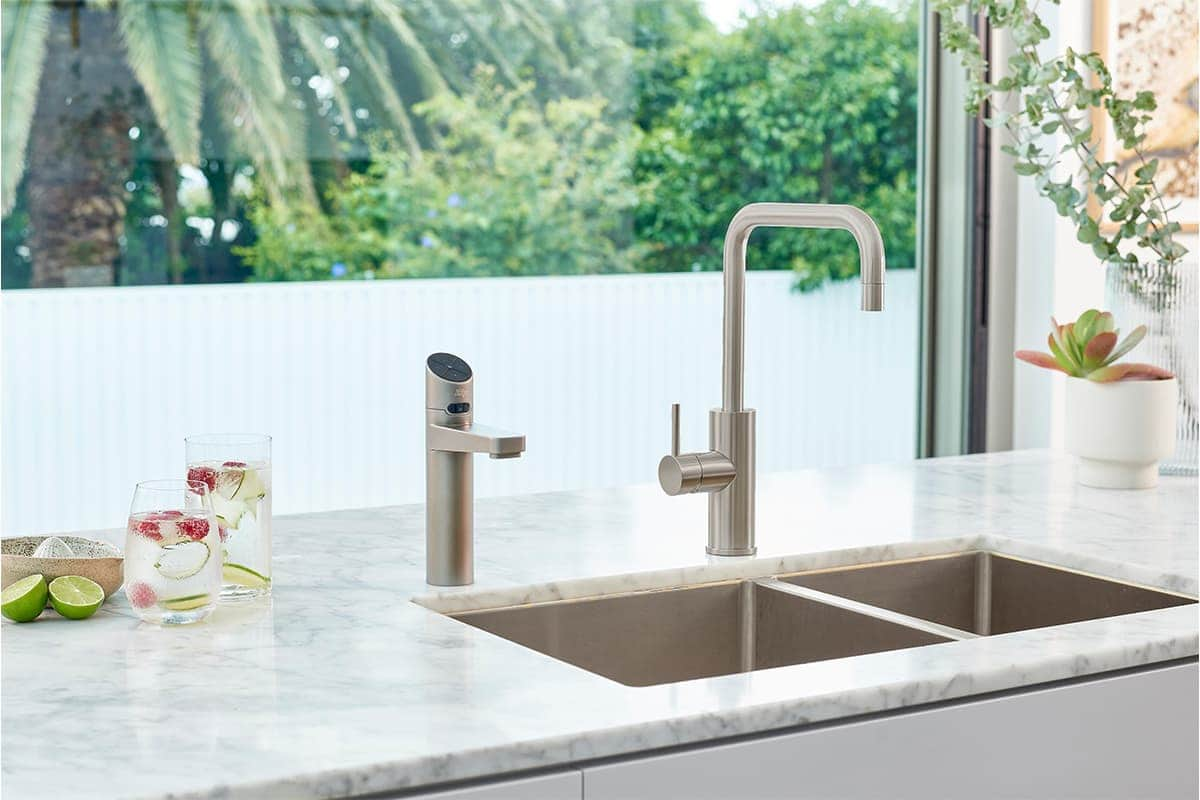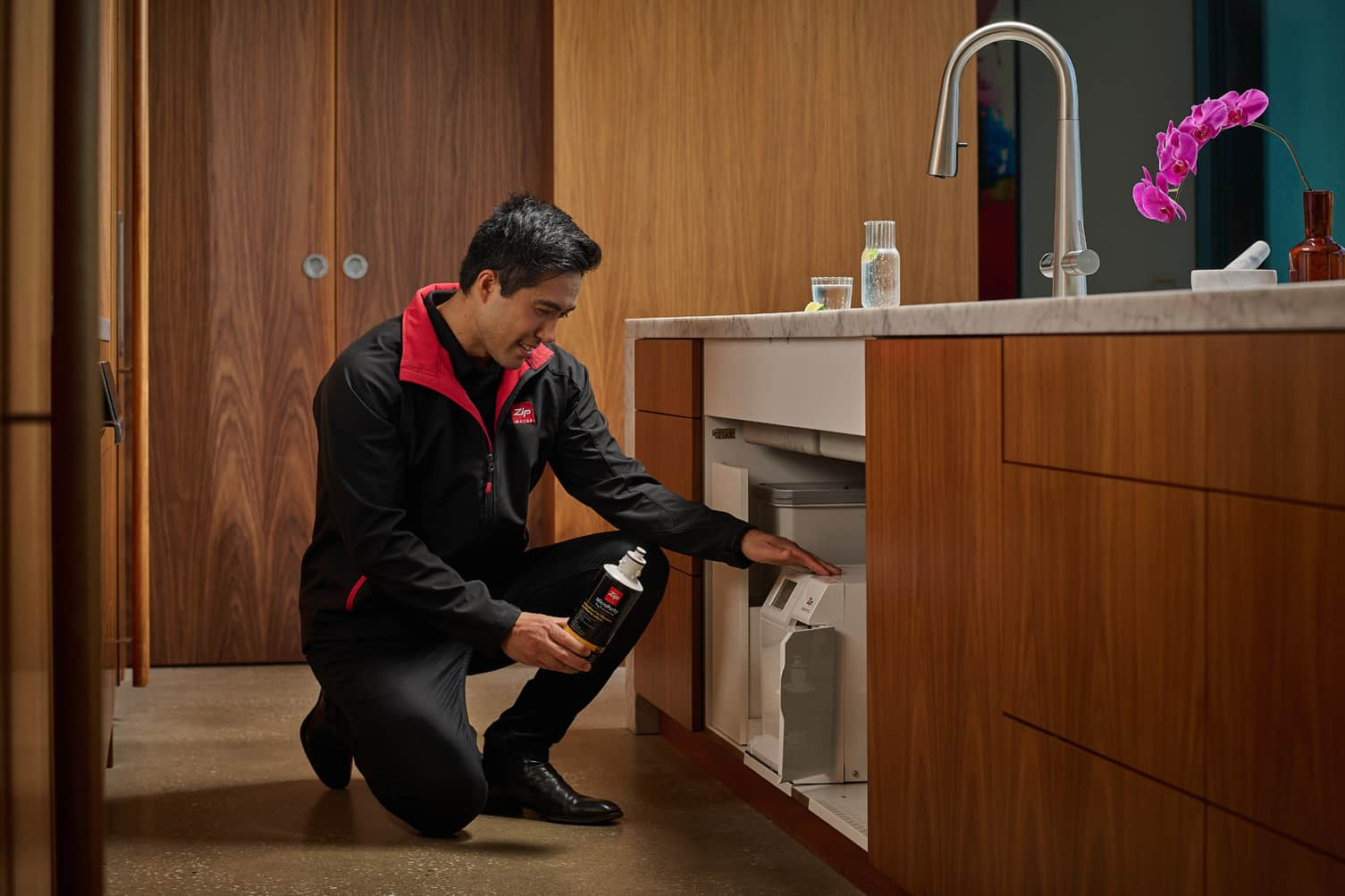Can PFAS Be Filtered Out of Water?
Health | 17-09-25

Can PFAS Be Filtered Out of Water? Everything You Need to Know
Yes – PFAS can be filtered out of water, but only with advanced, purpose-built technologies. The most effective options for homes are reverse osmosis, granular activated carbon (GAC), and ion exchange (and these are often used in combination). Results depend on proper certification and ongoing maintenance.
We’ll cover:
- What PFAS are
- Health risks
- Can PFAS be filtered out of water?
- How to filter PFAS out of water
- Australia’s stance on PFAS
- Important considerations about filtering PFAS
- How to choose the right water filter for you
What are PFAS, and why are they found in water?
PFAS stands for per- and polyfluoroalkyl substances, synthetic chemicals that have been used in manufacturing since the 1950s. They’re designed to resist heat, stains, oil and water, so you’ll you’ll find them in products such as:
- Non-stick pans
- Stain-resistant fabrics
- Waterproof jackets
- Food packaging
- Firefighting foam
Why are they in the spotlight now? Because their resistance to heat, water and oil also makes them incredibly persistent in the environment. They don’t break down easily. That means they can build up in soil and waterways.
Over time, PFAS can move through soil, surface water, and groundwater, spreading far from the original source. That’s why they’re now detected in drinking water supplies around the world, including in Australia. Even at very low concentrations, they can persist for many years and build up in water systems.
So what does this mean for you? It means PFAS aren’t just tied to industrial sites. They’re part of our wider environment, and that’s why they’re now showing up in the water that reaches our taps.
Health risks: what the science says
PFAS don’t just persist in the environment; they can also accumulate in the human body over time. Studies have shown that many people worldwide, including in Australia, already have measurable levels of PFAS in their blood.
Our understanding of the science is still evolving, but a 2022 study identified potential links between a range of health risks and long-term PFAS exposure, including:
- Effects on the immune system
- Liver and kidney issues
- Hormone disruption
- Certain types of cancer
- Developmental delays in children
Other studies found similar links. The Australian Government’s Expert Panel for PFAS also linked PFAS exposure to:
- Alterations in some indicators of immune response
- Reduced kidney function
- Increased levels of cholesterol and uric acid in the blood
- Altered levels of thyroid hormones and sex hormones
- Later age for starting menstruation in girls and earlier menopause
- Lower birth weight in babies
It’s important to note that research is ongoing. But the early signals are strong enough that both Australian and global regulators now treat PFAS as an emerging contaminant of concern
Can PFAS be filtered out of water?
The short answer is yes – PFAS can be filtered out of water, but only by specific technologies. Most common household filters are designed to improve taste or remove chlorine, and they won’t make a difference against PFAS.
So, can you filter PFAS out of water? You can, but it requires advanced systems. The three methods recognised globally as effective are:
- Reverse osmosis (RO)
- Granular activated carbon (GAC)
- Ion exchange (IX)
These are often combined in multi-stage systems to deliver consistent results. But even with these technologies, performance depends on two critical factors: independent certification and ongoing maintenance. Let’s look closer at what water filters remove PFAS.
How to filter PFAS from water
1. Reverse osmosis
Reverse osmosis is one of the most effective methods for reducing PFAS in drinking water. It works by pushing water through a semi-permeable membrane with pores so small that many dissolved substances (including PFAS molecules) are left behind. Reverse osmosis filters strip drinking water of a wide range of contaminants.
Reverse osmosis is recognised internationally as a proven treatment for PFAS. But there are some trade-offs. The process can also remove minerals that naturally occur in water, and it produces a stream of wastewater as part of its operation.
Reverse osmosis units are usually installed under the sink and may require professional fitting to ensure the system works properly.
2. Granular activated carbon (GAC) filtration
Granular activated carbon (GAC) filters are another proven way to reduce PFAS in drinking water. Instead of straining particles out like a sieve, GAC works through adsorption – where PFAS molecules cling to the surface of the porous carbon as water passes through.
The key to performance is contact time. The longer water flows through the carbon bed, the more opportunity there is for PFAS to stick. Depth and design matter too. A slim cartridge designed only for taste and odour may not capture PFAS at all.
GAC is generally more effective at reducing long-chain PFAS compounds such as PFOA and PFOS (which are some of the more harmful forms of PFAS). Short-chain varieties are harder to catch, which is why many systems combine GAC with other methods like ion exchange or reverse osmosis.
One limitation is that carbon eventually becomes saturated. Once exhausted, the filter can start letting contaminants through, which is why timely replacement is critical. Without it, performance drops off quickly.
3. Ion exchange resins
Ion exchange resins are another technology used to reduce PFAS in drinking water. These resins are made up of tiny beads that act like magnets for certain charged molecules. As water passes through, PFAS compounds are trapped on the resin while harmless ions are released into the water in their place.
Ion exchange is particularly useful for targeting short-chain PFAS compounds, which are harder to capture with carbon alone. For this reason, ion exchange is often paired with granular activated carbon or reverse osmosis in multi-stage systems.
Like carbon, ion exchange resins have a finite capacity. Over time the beads become saturated and must be replaced or regenerated.
Ion exchange systems are less common in domestic settings than carbon or RO, but they are increasingly included in advanced point-of-use filters designed to meet rigorous certification standards.
4. Other methods (what’s emerging, what’s not for home use)
Beyond reverse osmosis, carbon, and ion exchange, there are other technologies being explored for PFAS removal. Nanofiltration membranes, advanced oxidation processes, foam fractionation, and high-pressure systems are all under study or applied in specialised industrial settings.
These methods can be effective under controlled conditions, but they come with significant cost, energy use, or technical complexity. At this stage, they’re not practical for household use.
The most reliable way to reduce PFAS at home remains certified point-of-use systems that use reverse osmosis, granular activated carbon, ion exchange, or a combination of these approaches.
Now, another consideration: when it comes to filtering PFAS from water, where you place the filter matters just as much as the technology inside it.
Point of use vs point of entry systems
Point of use (POU) systems sit at the tap (typically under the kitchen sink), so they only treat the water you drink or cook with. The flow is slower and more controlled, so these systems can maintain the contact time needed for effective PFAS reduction. They’re also easier to certify, maintain, and replace on schedule.
Point of entry (POE) systems treat all the water coming into your home. That means showers, toilets, washing machines, and outdoor taps as well as drinking water. While this sounds comprehensive, it also means much higher volumes of water, faster flow rates, and therefore less certainty that you will consistently meet PFAS reduction targets.
If you’re weighing the two, here’s a simple way to decide:
- Do you want to reduce PFAS in the water you drink and cook with? POU is usually the best fit.
- Do you need to filter all household water for another reason (such as hard water issues)? Consider POE, but understand PFAS reduction may be less reliable.
- Are you looking for independent certification that specifically confirms PFAS reduction? You’ll find it more often in POU systems.
Okay, let’s look at why certification is so important for filtering PFAS out of water.
Testing and verification
Unlike chlorine or sediment, PFAS can’t be seen, tasted, or smelled. Confirming their presence requires specialised laboratory testing, which is expensive and not part of routine household checks. For most homes, this makes regular testing impractical.
Instead, the most reliable safeguard is to choose a filtration system that has been independently certified for PFAS reduction. Several international standards apply:
- NSF/ANSI 42 – For aesthetic claims (taste, chlorine, odour)
- NSF/ANSI 53 – For health claims (like PFAS, lead or asbestos)
- NSF/ANSI 401 – For Emerging Compounds/Incidental Contaminants or PFAS reduction (like Microplastics)
Before you buy, look for performance data sheets that show independent laboratory results against these standards. If a filter has been tested to NSF/ANSI 53 specifically for PFAS, you can be confident it’s designed for the job.
In higher-risk areas (such as private bores near known contamination sites), formal PFAS testing may be worth considering. Local water authorities or environmental agencies can advise where this applies. But for most Australians, certification and proper maintenance are the most practical ways to ensure a filter continues reducing PFAS effectively.
What is Australia's position on PFAS in water?
Australia was one of the first countries to establish health-based guideline values for PFAS in drinking water. The Australian Drinking Water Guidelines (ADWG) sets limits for compounds such as PFOS, PFOA, and PFHxS. These values are deliberately conservative, reflecting a precautionary approach in the face of emerging evidence.
Responsibility for monitoring sits with state and territory governments, alongside water utilities. Water supplies meet ADWG values in most urban centres.
But there are important exceptions. Areas near Defence bases, airports and firefighting training grounds have recorded higher PFAS levels due to the historic use of firefighting foams. Regional supplies drawn from private bores can also be more variable.
The Australian Government’s PFAS Taskforce continues to coordinate national responses, including contaminated site management, clean-up programs and ongoing reviews of scientific evidence. States such as NSW and QLD have also developed their own guidance and action plans to monitor and reduce risks.
Australia’s stance is broadly aligned with global best practice, drawing on research from agencies such as the US Environmental Protection Agency (EPA) and the World Health Organisation (WHO). In many cases, Australia’s guideline values are more conservative than international benchmarks.
For households, the message is clear: while public water supplies are carefully managed and considered safe, PFAS remain an emerging contaminant of concern. Choosing a certified point-of-use filtration system adds an extra layer of certainty.
Important considerations when choosing a PFAS filter
Not every filter that claims to “purify” water can remove PFAS. When choosing how to filter PFAS from water at home, there are a few key details to consider.
Certification is key
Look for filters independently certified to NSF/ANSI Standard 53 for PFAS reduction. Standards 42 and 401 cover other important claims – like chlorine, taste and odour (42) or emerging contaminants such as pharmaceuticals and microplastics (401).
Micron rating isn’t enough
A filter’s pore size is important (e.g., 0.2 micron) because it tells you how well it can block particles like microplastics. But PFAS are dissolved chemicals. Reducing them depends on adsorption or ion exchange (not just pore size).
Contact time and flow rate
PFAS removal is more effective when water spends long enough in contact with the filter media. High flow rates speed up your water and can reduce performance, which is why system design matters.
Capacity and replacement schedule
Every filter has a lifespan (usually measured in litres or months). So, eventually, PFAS and other contaminants will pass straight through. Always stick to your replacement schedule.
Choosing a PFAS filter isn’t just about buying the most advanced technology. You need to check for the right certifications, understand the system’s limits, and commit to proper maintenance.
A simple decision path (how to choose, step by step)
Filtering PFAS out of water doesn’t have to be complicated. Follow these steps to choose a system that will actually do the job.
1. Define your scope
Focus on the water you drink and cook with. Point-of-use systems (usually installed under the kitchen sink) are the most practical choice for PFAS.
2. Choose a proven method
Look for systems that use reverse osmosis, granular activated carbon, ion exchange (or a combination of these). These are the only approaches recognised globally for reducing PFAS.
3. Check the certification
Don’t just trust the label “filtered.” Make sure the system is independently certified to NSF/ANSI Standard 53 for PFAS reduction.
4. Confirm capacity and flow
Ensure the system is designed for your household size, water pressure, and daily use. Performance depends on having the right contact time and flow rate.
5. Plan for maintenance
Mark the replacement schedule on your calendar or set reminders. A filter past its rated life won’t reduce PFAS, no matter how advanced it is.
6. Keep records
Track when you installed and replaced filters, and note any service checks. This helps maintain consistency and peace of mind.
What is Zip Water doing about PFAS in water?
At Zip Water, we take PFAS seriously. When it comes to your drinking water, every detail matters.
We know that PFAS chemicals aren’t going away any time soon. That’s why our MicroPurity filtration system is engineered to reduce PFAS from the water you drink every day – alongside other contaminants you can’t see, smell or taste.
Independently certified PFAS reduction
Zip’s MicroPurity 93701 & 93702 filters are now independently tested and certified to reduce 99.4% of total PFAS. Third-party testing was conducted by an NSF/ANSI-accredited laboratory to the stringent NSF/ANSI standard, so you can trust the results in your home.
A broader approach to filtration
Of course, PFAS is only part of the picture. Zip MicroPurity also filters out:
- Microplastics
- Lead
- Asbestos fibres
- Cryptosporidium and Giardia
- Sediment
- Chlorine, taste and odours
- Bacteriostatic effects
… all down to 0.2 microns, using a multi-stage activated carbon and sediment block system.
And because we know performance depends on upkeep, we make filter maintenance easy. You’ll get automatic alerts and simple replacement options.
Smart water, made simple
Whether you choose a HydroTap with boiling, chilled or sparkling water, or a dedicated filtration-only model, you’re choosing water that’s cleaner, safer, and easier to enjoy.
Learn more about Zip Water’s MicroPurity PFAS filtration, or explore the HydroTap range to see how it fits into your kitchen. Need help deciding? The HydroTap Selector Tool is a great place to start.
* Zip MicroPurity filters sizes 1 and 1.5 (93701 and 93702) are certified to NSF/ANSI Standard 53 to reduce 99.4% of Total PFAS (average reduction).























